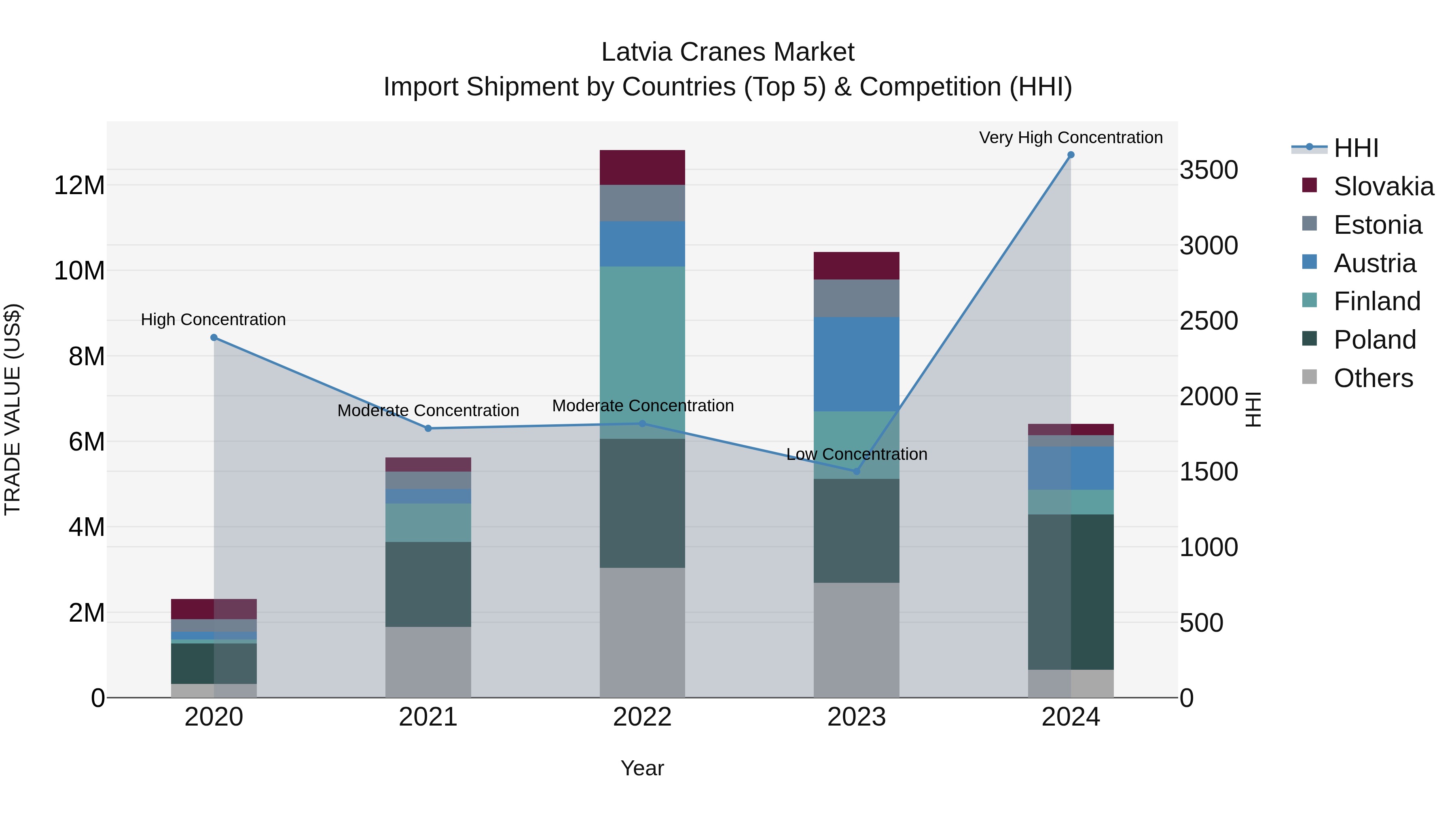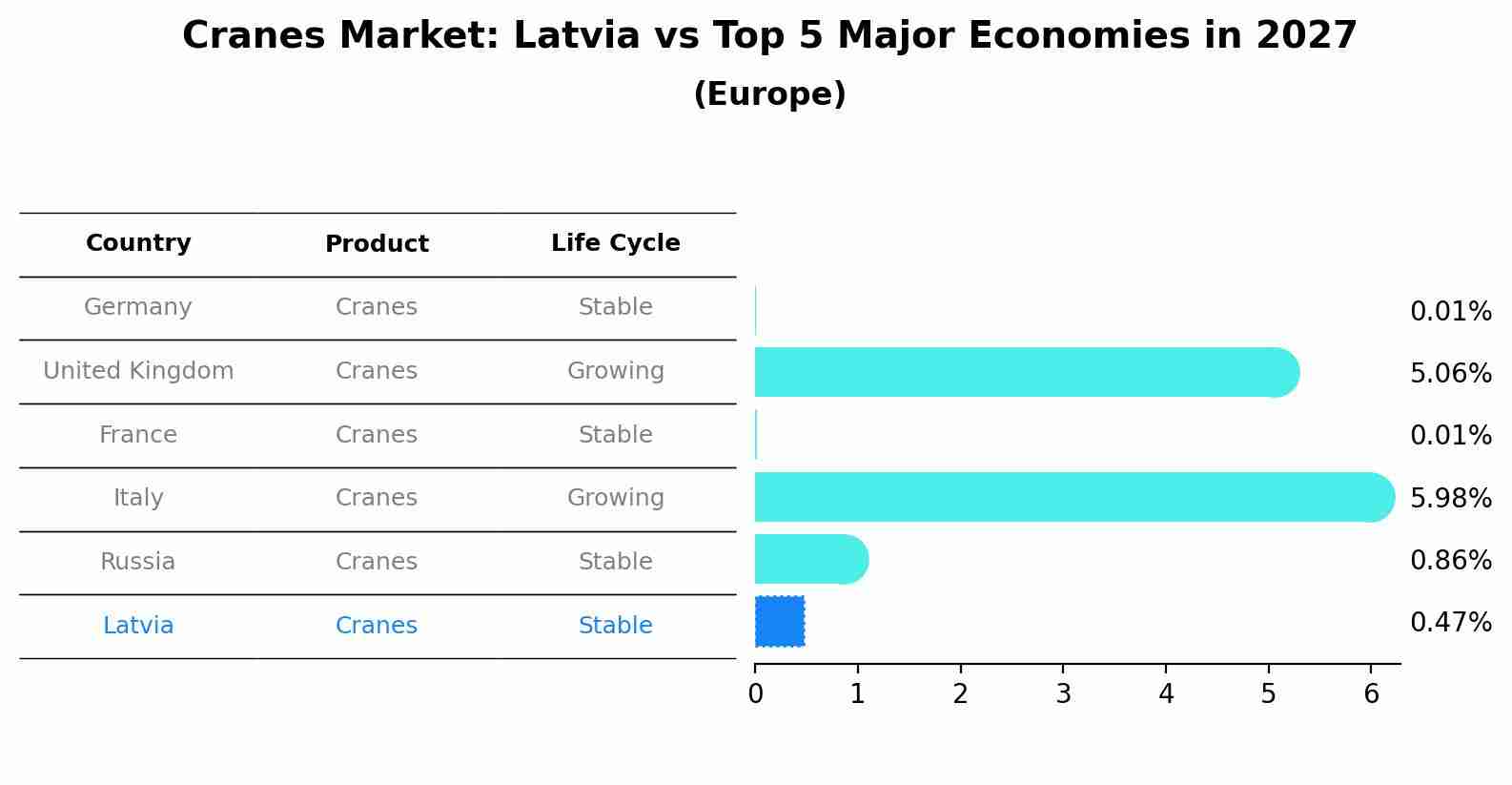Latvia Cranes Market (2025-2031) | Forecast, Segmentation, Revenue, Industry, Growth, Trends, Value, Outlook, Share, Companies, Size & Analysis
| Product Code: ETC5177212 | Publication Date: Nov 2023 | Updated Date: Nov 2025 | Product Type: Market Research Report | |
| Publisher: 6Wresearch | No. of Pages: 60 | No. of Figures: 30 | No. of Tables: 5 | |
Latvia Cranes Market Top 5 Importing Countries and Market Competition (HHI) Analysis
The Latvia cranes import market saw a significant shift in 2024 with top exporters being Poland, Austria, Finland, Slovakia, and Estonia. The market experienced a notable increase in market concentration, indicating a more competitive landscape. Despite a high growth rate from 2020 to 2024 at 29.02% CAGR, there was a sharp decline in growth from 2023 to 2024 at -38.59%. This fluctuation suggests a dynamic market environment influenced by various factors. Stakeholders should closely monitor these trends to make informed decisions in this evolving market.

Cranes Market: Latvia vs Top 5 Major Economies in 2027 (Europe)
By 2027, the Cranes market in Latvia is anticipated to reach a growth rate of 0.47%, as part of an increasingly competitive Europe region, where Germany remains at the forefront, supported by United Kingdom, France, Italy and Russia, driving innovations and market adoption across sectors.

Key Highlights of the Report:
- Latvia Cranes Market Outlook
- Market Size of Latvia Cranes Market, 2024
- Forecast of Latvia Cranes Market, 2031
- Historical Data and Forecast of Latvia Cranes Revenues & Volume for the Period 2021-2031
- Latvia Cranes Market Trend Evolution
- Latvia Cranes Market Drivers and Challenges
- Latvia Cranes Price Trends
- Latvia Cranes Porter`s Five Forces
- Latvia Cranes Industry Life Cycle
- Historical Data and Forecast of Latvia Cranes Market Revenues & Volume By Product Type for the Period 2021-2031
- Historical Data and Forecast of Latvia Cranes Market Revenues & Volume By Mobile for the Period 2021-2031
- Historical Data and Forecast of Latvia Cranes Market Revenues & Volume By Fixed for the Period 2021-2031
- Historical Data and Forecast of Latvia Cranes Market Revenues & Volume By Marine for the Period 2021-2031
- Historical Data and Forecast of Latvia Cranes Market Revenues & Volume By End-User for the Period 2021-2031
- Historical Data and Forecast of Latvia Cranes Market Revenues & Volume By Construction for the Period 2021-2031
- Historical Data and Forecast of Latvia Cranes Market Revenues & Volume By Mining for the Period 2021-2031
- Historical Data and Forecast of Latvia Cranes Market Revenues & Volume By Industrial for the Period 2021-2031
- Historical Data and Forecast of Latvia Cranes Market Revenues & Volume By Oil & Gas for the Period 2021-2031
- Historical Data and Forecast of Latvia Cranes Market Revenues & Volume By Others for the Period 2021-2031
- Latvia Cranes Import Export Trade Statistics
- Market Opportunity Assessment By Product Type
- Market Opportunity Assessment By End-User
- Latvia Cranes Top Companies Market Share
- Latvia Cranes Competitive Benchmarking By Technical and Operational Parameters
- Latvia Cranes Company Profiles
- Latvia Cranes Key Strategic Recommendations
Frequently Asked Questions About the Market Study (FAQs):
1 Executive Summary |
2 Introduction |
2.1 Key Highlights of the Report |
2.2 Report Description |
2.3 Market Scope & Segmentation |
2.4 Research Methodology |
2.5 Assumptions |
3 Latvia Cranes Market Overview |
3.1 Latvia Country Macro Economic Indicators |
3.2 Latvia Cranes Market Revenues & Volume, 2021 & 2031F |
3.3 Latvia Cranes Market - Industry Life Cycle |
3.4 Latvia Cranes Market - Porter's Five Forces |
3.5 Latvia Cranes Market Revenues & Volume Share, By Product Type, 2021 & 2031F |
3.6 Latvia Cranes Market Revenues & Volume Share, By End-User, 2021 & 2031F |
4 Latvia Cranes Market Dynamics |
4.1 Impact Analysis |
4.2 Market Drivers |
4.2.1 Increasing construction activities in Latvia |
4.2.2 Growing investments in infrastructure development |
4.2.3 Technological advancements in crane equipment |
4.2.4 Demand for efficient and eco-friendly cranes |
4.2.5 Government initiatives supporting construction sector growth |
4.3 Market Restraints |
4.3.1 High initial investment cost of cranes |
4.3.2 Fluctuating raw material prices impacting crane manufacturing |
4.3.3 Shortage of skilled crane operators |
4.3.4 Stringent regulations and safety standards |
4.3.5 Economic uncertainties affecting construction projects |
5 Latvia Cranes Market Trends |
6 Latvia Cranes Market Segmentations |
6.1 Latvia Cranes Market, By Product Type |
6.1.1 Overview and Analysis |
6.1.2 Latvia Cranes Market Revenues & Volume, By Mobile, 2021-2031F |
6.1.3 Latvia Cranes Market Revenues & Volume, By Fixed, 2021-2031F |
6.1.4 Latvia Cranes Market Revenues & Volume, By Marine, 2021-2031F |
6.2 Latvia Cranes Market, By End-User |
6.2.1 Overview and Analysis |
6.2.2 Latvia Cranes Market Revenues & Volume, By Construction, 2021-2031F |
6.2.3 Latvia Cranes Market Revenues & Volume, By Mining, 2021-2031F |
6.2.4 Latvia Cranes Market Revenues & Volume, By Industrial, 2021-2031F |
6.2.5 Latvia Cranes Market Revenues & Volume, By Oil & Gas, 2021-2031F |
6.2.6 Latvia Cranes Market Revenues & Volume, By Others, 2021-2031F |
7 Latvia Cranes Market Import-Export Trade Statistics |
7.1 Latvia Cranes Market Export to Major Countries |
7.2 Latvia Cranes Market Imports from Major Countries |
8 Latvia Cranes Market Key Performance Indicators |
8.1 Average utilization rate of cranes in Latvia |
8.2 Number of new crane installations in key construction projects |
8.3 Average age of cranes in operation |
8.4 Rate of adoption of advanced crane technologies |
8.5 Number of crane operator certifications issued |
9 Latvia Cranes Market - Opportunity Assessment |
9.1 Latvia Cranes Market Opportunity Assessment, By Product Type, 2021 & 2031F |
9.2 Latvia Cranes Market Opportunity Assessment, By End-User, 2021 & 2031F |
10 Latvia Cranes Market - Competitive Landscape |
10.1 Latvia Cranes Market Revenue Share, By Companies, 2024 |
10.2 Latvia Cranes Market Competitive Benchmarking, By Operating and Technical Parameters |
11 Company Profiles |
12 Recommendations | 13 Disclaimer |
- Single User License$ 1,995
- Department License$ 2,400
- Site License$ 3,120
- Global License$ 3,795
Search
Related Reports
- Vietnam System Integrator Market (2025-2031) | Size, Companies, Analysis, Industry, Value, Forecast, Growth, Trends, Revenue & Share
- ASEAN and Thailand Brain Health Supplements Market (2025-2031) | Strategy, Consumer Insights, Analysis, Investment Trends, Opportunities, Growth, Size, Share, Industry, Revenue, Segments, Value, Segmentation, Supply, Forecast, Restraints, Outlook, Competition, Drivers, Trends, Demand, Pricing Analysis, Competitive, Strategic Insights, Companies, Challenges
- ASEAN Bearings Market (2025-2031) | Strategy, Consumer Insights, Analysis, Investment Trends, Opportunities, Growth, Size, Share, Industry, Revenue, Segments, Value, Segmentation, Supply, Forecast, Restraints, Outlook, Competition, Drivers, Trends, Demand, Pricing Analysis, Competitive, Strategic Insights, Companies, Challenges
- Europe Flooring Market (2025-2031) | Outlook, Share, Industry, Trends, Forecast, Companies, Revenue, Size, Analysis, Growth & Value
- Saudi Arabia Manlift Market (2025-2031) | Outlook, Size, Growth, Trends, Companies, Industry, Revenue, Value, Share, Forecast & Analysis
- Uganda Excavator, Crane, and Wheel Loaders Market (2025-2031) | Strategy, Consumer Insights, Analysis, Investment Trends, Opportunities, Growth, Size, Share, Industry, Revenue, Segments, Value, Segmentation, Supply, Forecast, Restraints, Outlook, Competition, Drivers, Trends, Demand, Pricing Analysis, Competitive, Strategic Insights, Companies, Challenges
- Rwanda Excavator, Crane, and Wheel Loaders Market (2025-2031) | Strategy, Consumer Insights, Analysis, Investment Trends, Opportunities, Growth, Size, Share, Industry, Revenue, Segments, Value, Segmentation, Supply, Forecast, Restraints, Outlook, Competition, Drivers, Trends, Demand, Pricing Analysis, Competitive, Strategic Insights, Companies, Challenges
- Kenya Excavator, Crane, and Wheel Loaders Market (2025-2031) | Strategy, Consumer Insights, Analysis, Investment Trends, Opportunities, Growth, Size, Share, Industry, Revenue, Segments, Value, Segmentation, Supply, Forecast, Restraints, Outlook, Competition, Drivers, Trends, Demand, Pricing Analysis, Competitive, Strategic Insights, Companies, Challenges
- Angola Excavator, Crane, and Wheel Loaders Market (2025-2031) | Strategy, Consumer Insights, Analysis, Investment Trends, Opportunities, Growth, Size, Share, Industry, Revenue, Segments, Value, Segmentation, Supply, Forecast, Restraints, Outlook, Competition, Drivers, Trends, Demand, Pricing Analysis, Competitive, Strategic Insights, Companies, Challenges
- Israel Intelligent Transport System Market (2025-2031) | Strategy, Consumer Insights, Analysis, Investment Trends, Opportunities, Growth, Size, Share, Industry, Revenue, Segments, Value, Segmentation, Supply, Forecast, Restraints, Outlook, Competition, Drivers, Trends, Demand, Pricing Analysis, Competitive, Strategic Insights, Companies, Challenges
Industry Events and Analyst Meet
Our Clients
Whitepaper
- Middle East & Africa Commercial Security Market Click here to view more.
- Middle East & Africa Fire Safety Systems & Equipment Market Click here to view more.
- GCC Drone Market Click here to view more.
- Middle East Lighting Fixture Market Click here to view more.
- GCC Physical & Perimeter Security Market Click here to view more.
6WResearch In News
- Doha a strategic location for EV manufacturing hub: IPA Qatar
- Demand for luxury TVs surging in the GCC, says Samsung
- Empowering Growth: The Thriving Journey of Bangladesh’s Cable Industry
- Demand for luxury TVs surging in the GCC, says Samsung
- Video call with a traditional healer? Once unthinkable, it’s now common in South Africa
- Intelligent Buildings To Smooth GCC’s Path To Net Zero













